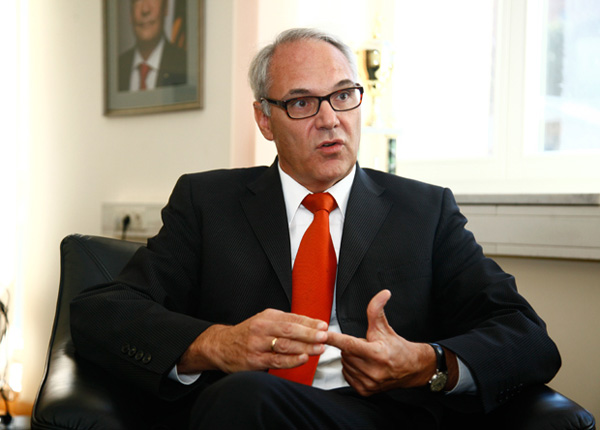Assures the German Ambassador to Armenia, Matthias Kiesler, meaning the cultural events
Back in early 19th century, Germans were interested in Armenians and Armenia. For example, “The Armenian Highland” concept was put into a scientific circulation by geologist Herman Abich. Scientists Hubshman, Markwart and others have done great services to the Armenian studies, and Josef Strzygowski “opened the eyes of the world” on the uniqueness of the Armenian architecture. Many Armenian students who later became prominent figures in science and culture have received their education in German universities until the World War I. Komitas studied in Germany conservatories.
Recently, perhaps, one of the biggest cultural events was held in Yerevan within the framework of the 10th Music Festival – the joint concert of National Philharmonic Orchestras of the city of Jena, Germany, and Armenia. The concert was dedicated to the Day of the unity of Germany and the 25th anniversary of Independence of Armenia. Today, Armenian prominent musicians live and create in Germany, including violinist Sergey Khachatryan. Soprano Hasmik Papian’s triumphal march started from the opera theaters in Germany. The Komitas International Competition-Festival and others are traditionally held in Pryottsel, Brandenburg, Germany. Today, Germany attracts the world’s best artists, especially musicians. Followed by this, “Aravot” commenced an interview with the German Ambassador to Armenia Matthias Kiesler.
We were also interested to know whether the country that has several dozens of orchestras and opera theaters has so many audiences of classical music. “In my country, classical art, including a large number of music audience, has been and will be. This is conditioned by the federal system, which is carried out by the municipal authorities without a single governance. Almost all major cities have their own orchestras and opera theaters,” – informed he. He also mentioned that the big number of Armenian musicians living and creating in his country is the talking evidence of the high quality of Armenian education. “In other words, in this case, we are on the same level,” – added Mr. Kiesler.
German artists are welcome guests to “High Fest” and “Golden Apricot” festivals. The Maxim Gorki Theater in Berlin, which once staged the performance of F. Werfel’s “The 40 Days of Musa Dagh” in Germany, recently played as Aurora in Yerevan. On this occasion, the Ambassador said that the role is played by Turkish by origin German artist, “In such a way, I think it is possible to support the establishment of mutual understanding between Armenian and Turkish societies.” During the interview, Matthias Kiesler recalled the events covering various sectors of culture (film screenings, reading and so on) first time organized by German-speaking institutions in Armenia.
To the question, by the initiative and funds of which side the Armenian events are mainly taking place, the ambassador said, “I am pleased to note that Armenia is the main initiator. Often, some German organizations also have a role in the event itself. For example, the Dresden Symphony Orchestra will arrive in Armenia on November supported by the German side. We kindly collaborate with our main partner – the Ministry of Culture of Armenia – on various projects. Incidentally, the latter is the hosting side of the Jena Orchestra. We have a wonderful partner in your country represented by the National Philharmonic Orchestra of Armenia, the “Golden Apricot”, “Yerevan Perspectives” Festivals.
To the question of whether the embassy does not think of including the marzes of Armenia as participants to the events, our interlocutor replied, “Undoubtedly, we attach much importance to the marz events. For example, the Jena Philharmonic musicians gave master classes in Gyumri. Once, we had organized exhibitions in Vanadzor and Sisian, various events in Gyumri, including the screening of silent films. In the near future, we will be expanded geographically too, not being focused only on the capital,” – said Matthias Kiesler.
Samvel DANIELYAN,
“Aravot

























































